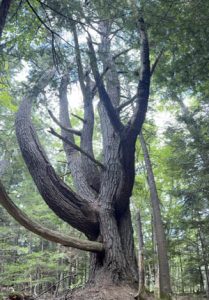Wrote Ed G recently:
@SandyLake_Park we discovered “The biggest White Pine I’ve ever seen ” this weekend.
The same Sandy Lake forest my grandfather took me on walks through and the reason I chose to become a forester.
It measured 345 cms girth and 109 cm diameter.
So important to protect these areas!
Indeed. It’s been added to the iNaturalist records for Sandy Lake.
Also view a related post on Sandy Lake Conservation Association Facebook Page.
Thx for observing and reporting on it Ed G!
A Comment
This tree could be described as a “Wolf Tree”.
“…a wolf tree is simply a tree that is much older–sometimes 100-200 years older–than the surrounding trees in the area. It has low-lying branches that spread wide in all directions. The terminology is thought to have originated from foresters in the late 1900s who believed that these old, massive trees were devouring too much space and sunlight; as a result, they were often eliminated from the landscape, similar to the wolves that were being hunted down for consuming too many forest resources. Trees with higher market value were planted in their place…
“Wolf trees are testaments to a property’s former life in agriculture. Often, farmers would leave a few nut-bearing trees to provide shade and free food to their livestock. Pasture would surround the tree, so it would grow wide, capturing as much sun as possible. There was no need to grow straight and tall because there were no other trees around to compete for space and sunlight. Later, when the farmer abandoned the field, trees would move in around the tree. Because there was now great competition for sunlight, they quickly grew tall and straight, eventually surpassing the height of the pasture-grown tree. With the increased shade begins the decline of the wolf tree.” – from Defining Our Landscapes: What Is a Wolf Tree by Alex for Heritage Conservancy, Feb 26, 2019.
I have also been told that for white pines, a “wolf tree” is a sign that the tree grew initially in the open where its terminal bud is subject to damage by the White pine weevil (Pissodes strobi) – for info about this pest, see White Pine Weevil Damage And Management Options by By Linda Williams, Wisconsin DNR Forest Health Specialist, June 9, 2023.
Comments retired Nova Scotia DNR pest and GIS specialist Bob Guscott:
I always love encountering wolf trees. I don’t really like the name, I tend to call them Grandmother Trees. These ancient individuals always have a story to tell. I think it is valid to attribute the extreme branching of old, white pine, wolf trees to earlier attacks of white pine weevil. Loggers would have avoided these forked and misshapen trees. Another factor which I think that often contributes to the shape and form of old white pine wolf trees is branch breakage as a result of wind and ice storms. Many of our oldest white pine trees carry deformities and scars from countless storms.
Wolf trees often occur as the result of early surveyors who would blaze prominent trees encountered on their survey lines (Bearing Trees) and on the corners (Witness trees). Many of these trees were not logged or cut down during land clearing because they often defined property boundaries.
I sometimes encounter large diameter wolf trees along our publicly owned and abandoned old coach/post roads in Nova Scotia. Some of our coach roads are over 200 years old, often protecting long lived trees, which exist within the 60 foot Right of Way.
The inference that as a Wolf Tree it may have grown in a more open area early on could be correct as close to the area where Ed observed the big pine, there are old stone fence lines and apple trees. There is also a massive White Ash (just off of the big parking lot), likely of the same vintage. And I have seen another Wolf Pine in that area.
Which reminds me: I need to measure that White Ash – which is on its “last legs” due to Emerald Ash Borer (first reported in NS in Bedford area in 2018 – CBC) – and the other Wolf Pine in the area and report on them as well! – david p

